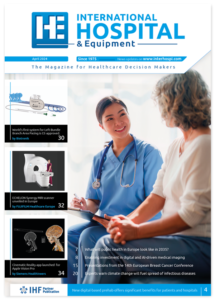Programmable heart patch cuts cardiac damage by 50% after myocardial infarction
MIT engineers have developed a flexible drug-delivery patch that can be placed on the heart after a heart attack, delivering therapeutics on a programmed schedule to promote healing and regeneration. In rat studies, the patch reduced damaged tissue by 50% and significantly improved cardiac function, offering a potential breakthrough for post-myocardial infarction treatment.
Heart attacks remain one of the world’s leading causes of death, with damaged cardiac tissue typically unable to regenerate effectively. Current surgical interventions like bypass surgery restore blood flow but cannot repair the underlying tissue damage. Now, researchers at MIT’s Koch Institute for Integrative Cancer Research have created a sophisticated drug-delivery system that addresses this limitation through precisely timed therapeutic release.
The technology, called TIMED (Temporal Intervention with Microparticle Encapsulation and Delivery), represents the first cardiac implantable platform with programmable sequential drug release. “When someone suffers a major heart attack, the damaged cardiac tissue doesn’t regenerate effectively, leading to a permanent loss of heart function,” explains Ana Jaklenec, principal investigator at MIT’s Koch Institute. “Our goal is to restore that function and help people regain a stronger, more resilient heart after a myocardial infarction.”
Miniature coffee cups deliver therapy on schedule
The patch’s innovative design incorporates drug-delivery microparticles that resemble tiny coffee cups with lids, fabricated from the biocompatible polymer PLGA. By adjusting the molecular weight of the polymers forming the lids, researchers can precisely control degradation rates, programming particles to release their contents at specific intervals – days 1-3, 7-9, and 12-14 after implantation.
This temporal control enables a therapeutic regimen aligned with the body’s natural healing phases. The first batch of particles releases neuregulin-1, a growth factor preventing cell death in the critical early hours post-infarction. At the second timepoint, VEGF promotes blood vessel formation around the heart during the proliferative phase. Finally, GW788388, a small molecule drug, inhibits scar tissue formation that commonly occurs after heart attack.
“When tissue regenerates, it follows a carefully timed series of steps,” notes Jaklenec. Lead author Dr Erika Wang “created a system that delivers key components at just the right time, in the sequence that the body naturally uses to heal.”
Tough hydrogel matrix ensures surgical viability
The microparticle arrays are embedded within a tough yet flexible hydrogel matrix composed of alginate and PEGDA, similar to contact lens material. The patch demonstrated an initial Young’s modulus of approximately 120 kPa with 480% elongation, making it suitable for placement on the contracting heart whilst maintaining structural integrity.
Importantly, the system showed remarkable storage stability. After one month of refrigeration at 4°C, the patch retained over 80% of encapsulated drug bioactivity and above 85% of mechanical strength, suggesting potential for “off-the-shelf” clinical application. The patches also withstood over two million stretch cycles simulating approximately one month of cardiac contractions.
Dramatic improvements in cardiac function
In rat models of myocardial infarction, the TIMED patch produced striking results. Animals receiving the patch showed 33% higher survival rates compared to untreated controls, with survival rates 17% better than intravenous injection of equivalent drugs. The treatment reduced damaged tissue by 50% and delivered significant improvements in cardiac output.
Functional assessments revealed that ejection fraction and fractional shortening – key measures of heart function – improved by more than 15% compared to both untreated myocardial infarction and intravenous controls at the four-week endpoint. Histological analysis confirmed a 53% increase in organised cardiomyocytes within the infarct region and a 2.6-fold increase in CD31-positive cells, indicating enhanced neovascularisation.
In human induced pluripotent stem cell-derived cardiac spheres subjected to hypoxic conditions, the patch reduced cell death by 47%, increased CD31-positive cells twofold, and decreased collagen deposition by 51%.
Unexpected anti-adhesion benefits
Beyond its primary therapeutic effects, the patch demonstrated a remarkable 69% reduction in post-surgical adhesions compared to control groups. This likely results from the timed release of the TGF-β inhibitor, which prevents excessive collagen deposition during later repair stages whilst preserving beneficial early collagen formation. This dual functionality could address complications from repeat cardiac surgery, where adhesions complicate surgical access.
Modular platform for broader applications
Whilst demonstrated for cardiac applications, the TIMED platform’s modular design extends beyond post-infarction therapy. The characterised microparticle library with release kinetics spanning one day to one month enables customisation of both drug combinations and release schedules for diverse sequential therapeutic strategies.
The researchers now plan to test the patches in additional animal models, with hopes of eventually conducting clinical trials. They are also exploring incorporation of these microparticles into stents for catheter-based delivery, potentially enabling minimally invasive deployment.
“This is an important way to combine drug delivery and biomaterials to potentially new treatments for patients,” says Robert Langer, David H. Koch Institute Professor at MIT and senior author of the study.
Reference
Wang, E.Y., Calle, E.A., Ying, B., et, al (2026). TIMED: Temporal intervention with microparticle encapsulation and delivery – A programmed release system for post-myocardial infarction therapy. Cell Biomaterials, 2, 100249. https://doi.org/10.1016/j.celbio.2025.100249


